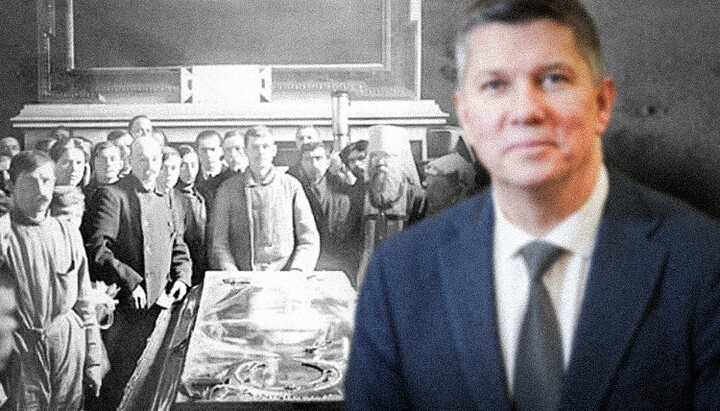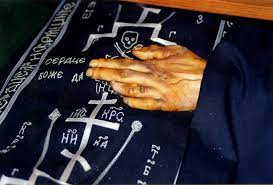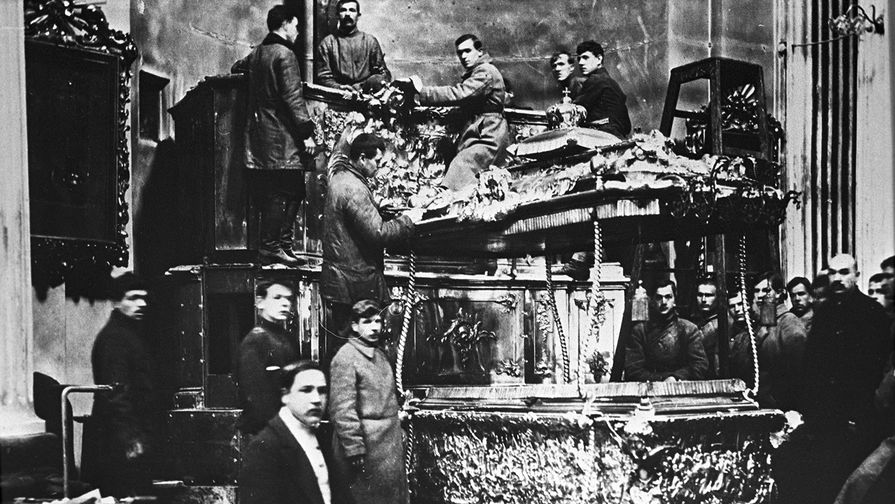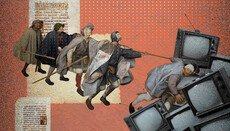Why an "inventory" of relics is needed

The Ministry of Culture announced the upcoming "inventory" of the Kyiv-Pechersk Lavra’s relics, similar to the actions of the Bolsheviks in 1918. Why is it needed?
As TSN reports, an "inventory" of the relics of the saints is planned at the Kyiv-Pechersk Lavra. Maryana Tomin, the director of the Department for Cultural Heritage of the Ministry of Culture and the part-time head of the Commission on the transfer of objects of the Kyiv-Pechersk Lavra to the state, said: "In two weeks, we will start the commission that will take an inventory of the unburied remains of Kyiv-Pechersk Lavra saints. We will work together with anthropologists, military chaplains and archaeologists. And we want to check everything that concerns the unburied remains of the saints."
What the Ministry of Culture is talking about
What draws attention in the words of this official?
Firstly, she calls the holy relics "unburied remains". Is this a hint that they should be buried? Most likely, this is the church illiteracy of M. Tomin, but perhaps she spoke about a certain intention. The fact is that in the caves, there are relics of saints who have a direct relation to the cities of today's Russia. For example, St. Kuksha, who preached Christianity on the territory of the Orel and Kaluga regions; St. Mercury, who was a bishop in Smolensk, St. Simon and Dionisius, bishops of Suzdal, and so on. Can they be declared "wrong" saints and accomplices of the "Russian world" that have no place in the Ukrainian shrine? Absurd! But let's remember the current campaign against St. Alexander Nevsky and other saints. The OCU declared that it's time to reject them and removed Alexander Nevsky from its list of saints. And he, by the way, was the Grand Duke of Kiev in 1257-1259.
Secondly, the proposed composition of the commission that will make the "inventory" is very suspicious. M. Tomin stated that it would include anthropologists, archaeologists and military chaplains. But where are the representatives of the Church here? The authorities do not recognise the UOC priests as chaplains, which means that there will be representatives of the OCU, UGCC and possibly other denominations. This is despite the fact that it was the brethren of the Kyiv-Pechersk Lavra who have taken care of the relics, dressed them and monitored their safety for several decades. Will they be brought in for "inventory"? This is not implied from the official's words.
Thirdly, for what purpose does the Ministry of Culture want to "check everything that concerns the unburied remains of saints"? There is no answer to this question. But there is a historical precedent, very similar to what the Ministry of Culture is up to today. This is the campaign to uncover relics, which began in 1918 and lasted until the late 1920s.
The 1920-s campaign to open relics
The Bolsheviks had their own anti-church laws, although they were not passed by parliament but by the Council of People's Commissars and were called Decrees. On January 23, 1918, the Decree "On the Separation of Church from State and School from Church" was adopted, and the Liquidation Department of the People's Commissariat of Justice was created to implement it.
Today, a Telegram channel would be created to cover the activities of this Department, but at that time an anti-religious journal "Revolution and Church" was founded. Within the framework of this Decree on 22 October 1918, the Bolsheviks carried out their "inventory" at the Alexander Svirsky Monastery, opening the coffin with the incorrupt relics of St Alexander Svirsky. And the magazine "Revolution and Church" launched a powerful fake: instead of relics, a wax doll was allegedly found.
The report of the Liquidation Department says: "In a cast reliquary, weighing more than 20 poods of silver, instead of the 'incorrupt' relics of Alexander Svirsky, a wax doll was found."

The relics of St. Alexander Svirsky
The relics of St Alexander Svirsky have an amazing level of incorruption; they are not even mummified in in the usual sense, and look like the body of a recently deceased person (the reverend lived in the XV century). It is not known whether the members of the Liquidation Commission were so illiterate that they could not distinguish between wax and a real human body, or whether there was an order to announce it a "doll", but the news was spread by Bolshevik propaganda throughout the country.
There were reports of meetings of workers who were outraged at the "centuries-old deception of the priests" (today, the word "Moscow" will be added), demanding the opening of relics across the country. Thus, the campaign to uncover the relics began. Yemelyan Yaroslavsky, who led the anti-religious policy in the USSR, wrote in those days: "It is not for the sake of ridicule that the Soviet power establishes the truth, it is not for the sake of ridicule that it reveals the age-old deception of the monks".
Today, the head of the State Committee for Religious Affairs of the Ministry of Culture Viktor Yelensky speaks similarly, stating that not for the sake of infringing on religious rights, the authorities are persecuting the UOC.”

Uncovering the relics of St. Alexander Nevsky, 1922
Throughout the country, a campaign to open relics began. It must be acknowledged that the Bolsheviks established a special procedure for this. It was the clergy who were to open the reliquary and remove the vestments and decorations from the relics while representatives of local authorities, the Cheka (the All-Russian Extraordinary Commission), medical experts, and members of the public were only supposed to observe and then sign the inspection protocol together with the clerics.
The Ukrainian descendants of the Bolsheviks decided to go even further and plan to conduct an "inventory" without the involvement of UOC priests, who have been overseeing these relics for 30 years.
On 30 July 1920, the Council of People's Commissars adopted a resolution "On the Liquidation of Relics on an All-Russian Scale." It prescribed:
- systematically and consistently carrying out the complete liquidation of relics, avoiding any indecision and half-measures.
- the liquidation of the cult of dead bodies, dolls, etc., is carried out by transferring them to museums.
- in all cases of detecting charlatanism, trickery, falsifications, and other criminal acts aimed at exploiting ignorance <...> justice departments initiate legal proceedings against all guilty parties...
At the end of 1920, the journal "Revolution and Church" published the Report of the Liquidation Department of the People's Commissariat of Justice to the Congress of Soviets, summarizing the openings of 63 relics carried out in 1918-1920. Typically, partially preserved mummified remains were found, along with various degrees of preservation of some parts.
For example, in the reliquary of St. Sergius of Radonezh, according to the Report, there were "moth-eaten rags, cotton wool, half-decayed human bones, a mass of dead moths, butterflies, larvae, and reddish-brown hair in the skull wrapped in waxed paper of recent origin". In the reliquary of St Vladimir the Great, Grand Prince of Novgorod, "a heap of black bones, rags and dust, a skull split into two halves" were found.
Here it should be explained that according to Church teaching, any remains of saints, of any degree of incorruption, are considered as holy relics. Even articles of clothing of saints are objects of veneration. Within reasonable limits, this is not magic or idolatry. As far back as the Book of Acts of the Apostles mentions that: "But God wrought many miracles through Paul so that even handkerchiefs and aprons that had touched him were taken to the sick, and their illnesses were cured and the evil spirits left them" (Acts 19. 11-12). Those who have attended prayer services in the caves of the Kyiv-Pechersk Lavra and in other monasteries these days can confirm this. When, for example, the hat of the Monk Mark the Grave Digger was put on the possessed, their possession was immediately revealed, sometimes in a horrible way.
It is also common practice to divide relics so that they can be venerated in different places, to separate the particles in order to sew them into antimensia, etc.
However, before the revolution of 1917, the people had a strong belief that the relics of saints were necessarily incorruptible remains. It was reinforced by the fact that relics were usually kept investments, under various covers, and so on. In other words, people did not see their condition. Discovering decayed bones in the reliquaries was a shock to them, which was exactly what the authorities counted on.
In addition to discrediting the Church, the authorities also expected to provoke people’s outrage to have a pretext for repression. Despite the established procedure for opening relics, this often occurred with particular cynicism. Red Army soldiers and representatives of the Cheka would shake cigarette ash into the coffins, spit, pour acid, threw them into sewage, and so on. This caused outrage among the believers, and if they dared to openly protest, the authorities conducted public reprisals, arrests, and even executions.
Why the authorities are doing this and what could be next
Firstly, the "inventory" is part of a general campaign to destroy the Church. The veneration of saints’ relics is a very ancient tradition, dating back to apostolic times. We can say that it is an integral part of Orthodoxy as such. As icon veneration is a testimony to the real incarnation of the Son of God, so the veneration of relics is a testimony to the real deification of man, to the reception of the Holy Spirit, which sanctifies the whole person with soul and body, which remains unchanged even after death. Any disrespectful treatment of relics offends the feelings of the faithful. This is exactly the kind of treatment that is expected during the "inventory". Let's hope that the commission members will not spit in the reliquaries and shake off cigarette ashes there, but they will not sing troparions and glorifications over them either (as the Lavra brethren did when re-dressing the relics).
Secondly, the commission will find that many relics are missing some parts. This will serve as a reason to accuse the UOC of squandering or, even worse, selling off the relics or handling them over to the aggressor country, i.e. Russia. There, indeed, many churches have particles of the relics of the Kyiv-Pechersk saints. The anti-Church media, the successors of the journal "Revolution and Church", will spread these accusations in every possible way and will raise in society an even greater wave of hatred towards the Church. The fact that the relics of the Kyiv-Pechersk saints have been transferred to monasteries and temples in various countries for a little less than a thousand years and that this is common practice everywhere will naturally not interest anyone.
Thirdly, based on the experience of the campaign to uncover relics in the 1920s, it can be assumed that believers will protest against the "inventory", which will give the authorities a pretext for further repression. The experience of the brutal crackdown on UOJ journalists, when people were jailed and threatened with life imprisonment for ordinary journalistic activities, shows that the authorities intend to act harshly against the Church and its faithful members.
How the "inventory" of relics will actually proceed, we will find out in two weeks. By and large, it will depend on the instructions the Ministry of Culture commission receives from the authorities.
If the authorities decide on tough actions at that time, then the "inventory" will be carried out accordingly. If the situation is different, the commission will conduct it in a "light" version: they will come, inspect, make up a report and leave. Or, perhaps, they will postpone the event indefinitely. This could happen if the international community clearly expresses dissatisfaction with the violation of religious freedom in Ukraine or if the authorities consider the risks of internal destabilization too great.
As for the believers, firstly, we need to strengthen our prayers, actively participate in prayer vigils near the Lavra and other holy places, and secondly, remember that we are Christians and cannot act in the same manner as the enemies of the Church. We cannot respond to evil with evil, harbor hatred or anything similar. Our duty is prayer and trust in God.
“Do not be anxious about anything, but in every situation, by prayer and petition, with thanksgiving, present your requests to God. And the peace of God, which transcends all understanding, will guard your hearts and your minds in Christ Jesus. Finally, brothers and sisters, whatever is true, whatever is noble, whatever is right, whatever is pure, whatever is lovely, whatever is admirable—if anything is excellent or praiseworthy—think about such things. Whatever you have learned or received or heard from me, or seen in me—put it into practice. And the God of peace will be with you" (Phil. 4: 6-9).











